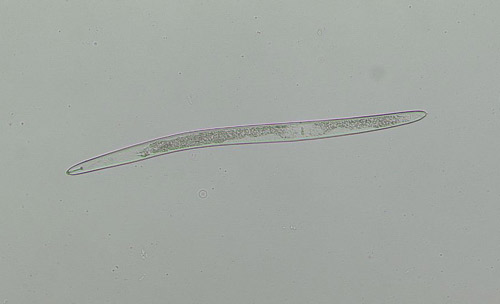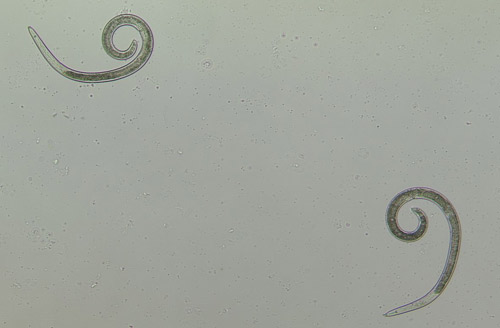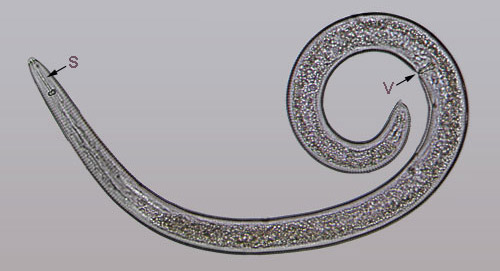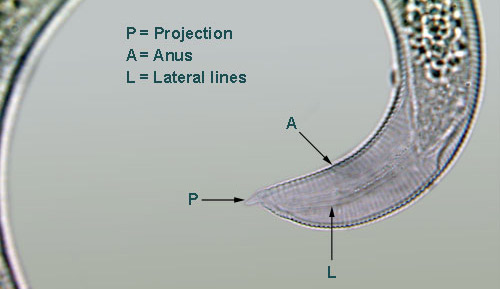common name: spiral nematode
scientific name: Helicotylenchus spp. (Nematoda: Tylenchida: Hoplolaimidae)
Introduction - Distribution - Life Cycle and Biology - Hosts - Symptoms - Identification - Economic Importance - Management - Selected References
Introduction (Back to Top)
The common name spiral nematode is most often applied to nematodes in the genus Helicotylenchus, but it is also sometimes applied to other genera in the family Hoplolaimidae, including Rotylenchus, Aorolaimus, Scutellonema, and Peltamigratus. These are called spiral nematodes because their bodies tend to curl into a spiral when the nematodes are relaxed or dead (Figure 1). Spiral nematodes of the genus Helicotylenchus are among the most ubiquitous plant-parasitic nematodes worldwide. Dozens of Helicotylenchus spp. have been reported in Florida associated with various cultivated horticultural, agronomic, ornamental, and turfgrass plants, and from natural habitats.
Figure 1. The body of Helicotylenchus spp. curves into a spiral when the nematode is dead or relaxed, hence the common name spiral nematode. This moving nematode is outstretched. Photograph by William T. Crow, University of Florida.
Figure 2. The body of Helicotylenchus and other spiral nematodes curve into a spiral when the nematode is dead or relaxed. These relaxed nematodes are curled into a spiral. Photograph by William T. Crow, University of Florida.
Distribution (Back to Top)
Helicotylenchus spp. are found in temperate and tropical regions on all continents (except Antarctica), on many islands, and throughout the United States. Helicotylenchus spp.can thrive in a wide range of soil types including heavy, sandy, and organic soils.
Life Cycle and Biology (Back to Top)
Reproduction is highly variable among species of Helicotylenchus. Some species, like Helicotylenchus muticinctus, reproduce sexually and have males and females that mate. Some species are hermaphrodites that self-fertilize their own eggs without mating. Other species, like Helicotylenchus pseudorobustus, reproduce asexually by parthenogenesis, do not mate, and have only females. Females lay eggs individually in soil. Inside each egg a first-stage juvenile develops and then molts into a second-stage juvenile before hatching. After hatching, the second-stage juvenile must locate a host plant and begin feeding for further development. Helicotylenchus spp. typically feed on cortical cells of host roots. The nematode inserts its mouth-spear (stylet) into the epidermis and cortical cells and ingests the cellular contents. In some cases, Helicotylenchus pseudorobustus induces development of a specialized food cell on which it feeds (Vovlas and Inserra 1985). This food cell is not larger than a typical cortical cell, but has denser cytoplasm and larger nucleus than a normal cell. Helicotylenchus pseudorobustus will generally stay in one location feeding on a single food cell, but can also move to a different location on the same or different root and induce a new food cell at the new location.
While generally considered an ectoparasite whose body remains outside of host tissue during feeding, occasionally Helicotylenchus pseudorobustus behaves as a semi-endoparasite and penetrates into the host root with its anterior body portion (head region). In contrast, Helicotylenchus multicinctus is a migratory endoparasite that enters completely into banana roots and moves in the lumen between cells, feeding on different cells as it migrates. After feeding, all Helicotylenchus spp. undergo three more molts into a third and fourth stage juvenile, and then into an adult. The various juvenile life stages of Helicotylenchus spp. look very similar to the adults, differing only in body size and lack of a developed reproductive system. Eggs of most species are deposited into the soil, although Helicotylenchus multicinctus lays eggs within banana roots.
Hosts (Back to Top)
Helicotylenchus spp. have a wide host range including fruit crops, vegetables, agronomic crops, ornamental plants, forages, turfgrasses, weeds, and plants in natural habitats. With the exception of Helicotylenchus multicinctus, spiral nematodes are not considered important pests on most hosts. However, often their damage has not been well quantified or documented. Research has shown that some Florida crops, such as soybean, cotton, and corn are damaged by Helicotylenchus pseudorobustus. Helicotylenchus multicinctus is an important nematode pest of banana in Florida (McSorley and Parrado 1983), and worldwide (McSorley and Parrado 1986). Helicotylenchus paxilli has been demonstrated to reduce growth of bermudagrass and seashore paspalum used on Florida golf courses (Pang et al. 2011, 2012).
Symptoms (Back to Top)
The symptoms of Helicotylenchus pseudorobustus are more subtle than those of certain other nematodes such as root-knot or sting nematodes. Heavy infection by Helicotylenchus spp. can cause a reduction in the root system, leading to unhealthy plants. On turfgrasses, Helicotylenchus paxilli has been shown to reduce root length and cause thinning of turf. Generally the turf decline will occur in patches (Figure 3) and is often accompanied by proliferation of weeds in the affected areas (Figure 4). Helicotylenchus multicinctus causes small necrotic lesions on roots, and with heavy infestation these lesions coalesce, leading to root necrosis and die-back of roots. Plant stunting and reduction in yield can result. Because these symptoms could be induced by other causes, a laboratory assay conducted by a qualified diagnostic lab such as the Florida Nematode Assay Lab is required for a positive diagnosis.
Figure 3. Seashore paspalum on a golf course fairway infested by Helicotylenchus paxilli. Nematode damage is visible as patches of declining turf. Photograph by William T. Crow, University of Florida.
Figure 4. A seashore paspalum golf tee box infested with Helicotylenchus paxilli. Nematode damage results in thinning turf and proliferation of weeds. Photograph by William T. Crow, University of Florida.
Identification (Back to Top)
As previously described, the body of Helicotylenchus spp. forms a complete spiral when the nematode is dead or relaxed. The vulva of the female is located around 2/3 of the nematode’s body length from the anterior terminus (Figure 5). The tail is asymmetrical, being curved dorsally with a rounded projection in many species (Figure 6). The presence of males is a useful biological character to separate Helicotylenchus multicinctus from species that do not have males. A combination of morphological evaluation, morphometrics, and molecular phylogenetic inference should be used to accurately determine the species of an individual population (Subbotin et al. 2015).
Figure 5. An adult Helicotylenchus paxilli. S = stylet (mouth spear) used for feeding. V = vulva, located around 60% of the body length from the anterior terminus. Photograph by William T. Crow, University of Florida.
Figure 6. The tail of Helicotylenchus pseudorobustus is asymmetrical and has a projection on the end. Photograph by William T. Crow, University of Florida.
Economic Importance (Back to Top)
While Helicotylenchus pseudorobustus is a parasite of many economically important plants, it is seldom considered a major pest on most of them. In Florida, seashore paspalum, a turfgrass used in tropical and subtropical regions, is particularly susceptible to infestation by Helicotylenchus paxilli. On this grass, Helicotylenchus paxilli is among the most common nematodes requiring nematicide application in Florida. While banana is not an important commercial crop in Florida, Helicotylenchus multicinctus is damaging to banana grown for local fruit consumption and ornamental banana growing in nurseries and landscapes. Another species that is very common on many crops, ornamentals, and other cultivated and non-cultivated plants in Florida is Helicotylenchus dihystera. However, the damage induced by this nematode in Florida has not been assessed.
Management (Back to Top)
The extensive host range of Helicotylenchus spp. makes management by use of crop rotation or cover crops very difficult. Because the body of Helicotylenchus spp. remains exposed in soil, it responds well to nematicides and bionematicides that are effective for management of other nematodes. On golf and sports turfgrasses, nematicides are applied for management of Helicotylenchus paxilli in Florida. Refer to Nematode Management for Golf Courses in Florida for current management recommendations on golf course turf. Sanitation, planting of nematode-free banana plants into non-infested soil, is currently the best control measure for Helicotylenchus multicinctus on banana in nurseries and landscapes.
Selected References (Back to Top)
- Fortuner R, Maggenti AR, Whittaker LM. 1984. Morphometrical variability in Helicotylenchus Steiner, 1945. 4: Study of field populations of H. pseudorobustus and related species. Revue Nematologie 7: 121-135.
- McSorley R, Parrado JL. 1983. The spiral nematode Helicotylenchus multicinctus on bananas in Florida and its control. Proceedings of the Florida State Horticultural Society 96: 201-207.
- McSorley R, Parrado JL. 1986. Helicotylenchus multicinctus on bananas: An international problem. Nematropica 16: 73-91.
- O’Bannon JH, Inserra RN. 1989. Helicotylenchus species as crop damaging parasitic nematodes. Nematology Circular 165. Florida Department of Agriculture and Consumer Services Division of Plant Industry.
- Pang W, Luc JE, Crow WT, Kenworthy KE, McSorly R, Kruse JK, Giblin-Davis RM. 2011. Responses of seashore paspalum cultivars to sting and spiral nematodes. Crop Science 51: 2864-2867.
- Pang W, Luc JE, Crow WT, Kenworthy, KE, Giblin-Davis RM, McSorley, R, Kruse JK. 2012. Field responses of bermudagrass and seashore paspalum to sting and spiral nematodes. Journal of Nematology 43: 201-208.
- Subbotin SA, Inserra RN, Marias M, Mullin P, Powers TO, Roberts PA, Van Den Berg E, Yates GW, Baldwin JG. 2011. Diversity and phylogenetic relationships within the spiral nematodes of Helicotylenchus Steiner, 1945 (Tylenchida: Hoplolaimidae) as inferred from analysis of the D2-D3 expansion segments of 28S rRNA gene sequences. Nematology 13: 333-345.
- Subbotin SA, Vovlas N, Yeates GW, Hallmann J, Kiewnick S, Chizhov VN, Manzanilla-Lopez RH, Inserra RN, Castillo P. 2015. Morphological and molecular characterisation of Helicotylenchus pseudorobustus (Steiner, 2014) Golden, 1956 and related species (Tylenchida: Holplolaimidae) with a phylogeny of the genus. Nematology 17: 27-52.
- Vovlas N, Inserra R. 1985. Single modified food cell induced by Helicotylenchus pseudorobustus in corn roots. Journal of Nematology 17: 371-373.
- Vovlas N, Larizza A. 1994. Embryonic patterns and parasitic habits of Helicotylenchus oleae and H. pseudorobustus. Afro-Asian Journal of Nematology 4: 17-21.



